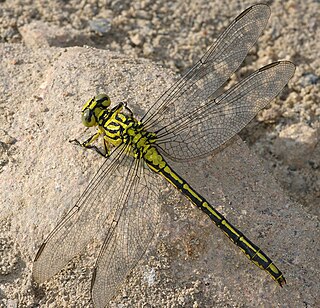
The lesser yellowlegs is a medium-sized shorebird. The genus name Tringa is the New Latin name given to the green sandpiper by Aldrovandus in 1599 based on Ancient Greek trungas, a thrush-sized, white-rumped, tail-bobbing wading bird mentioned by Aristotle. The specific flavipes is from Latin flavus, "yellow", and pes, "foot".

The yellow-footed antechinus, also known as the mardo, is a shrew-like marsupial found in Australia. One notable feature of the species is its sexual behavior. The male yellow-footed antechinus engages in such frenzied mating that its immune system becomes compromised, resulting in stress related death before it is one year old.

Reticulitermes flavipes, the eastern subterranean termite is the most common termite found in North America. These termites are the most economically important wood destroying insects in the United States and are classified as pests. They feed on cellulose material such as the structural wood in buildings, wooden fixtures, paper, books, and cotton. A mature colony can range from 20,000 workers to as high as 5 million workers and the primary queen of the colony lays 5,000 to 10,000 eggs per day to add to this total.
Carpet beetle may refer to any of several taxa of beetles:
The pale-footed swallow is a species of bird in the family Hirundinidae. It is found in the northern Andes, from Venezuela to Bolivia. It is monotypic.
The yellow-legged weaver is a species of bird in the Ploceidae family. It is endemic to Democratic Republic of the Congo.
Eumetopina flavipes, the island sugarcane planthopper, is a species of planthopper present throughout South East Asia. E. flavipes is a vector for Ramu stunt disease, a plant disease which affects sugarcane. Ramu stunt disease is widespread throughout Papua New Guinea, but has not been detected in Australia.

The river clubtail or yellow-legged dragonfly is a species of dragonfly in the family Gomphidae. It is found in Europe. Its natural habitat are rivers and large streams. The dragonfly flies from June to September depending on the location.
Enchelyurus flavipes, the yeloowfin blenny, is a species of combtooth blenny from the western Pacific Ocean. It occasionally makes its way into the aquarium trade.

Rhinotermitidae is a family of termites (Isoptera). They feed on wood and can cause extensive damage to buildings or other wooden structures. About 345 species are recognized, among these are severe pests such as Coptotermes formosanus, Coptotermes gestroi, and Reticulitermes flavipes.
Eugamandus is a genus of longhorn beetles of the subfamily Lamiinae. It was described by Warren Samuel Fisher in 1926.
Eugamandus brunneus is a species of longhorn beetles of the subfamily Lamiinae. It was described by Fisher in 1935.
Eugamandus oakleyi is a species of longhorn beetles of the subfamily Lamiinae. It was described by Fisher in 1935.
Eugamandus cayamae is a species of longhorn beetles of the subfamily Lamiinae. It was described by Fisher in 1926, and is known from Cuba.
Eugamandus darlingtoni is a species of longhorn beetles of the subfamily Lamiinae. It was described by Fisher in 1942, and is known from Dominicana.
Eugamandus jamaicensis is a species of longhorn beetles of the subfamily Lamiinae. It was described by Vitali in 2003, and is known from Jamaica, from which its species epithet is derived.
Eugamandus ricarti is a species of longhorn beetles of the subfamily Lamiinae. It was described by Micheli in 2003, and is known from Puerto Rico.
Eugamandus schwarzi is a species of longhorn beetles of the subfamily Lamiinae. It was described by Fisher in 1926, and is known from Cuba.
Eugamandus tuberculatus is a species of longhorn beetles of the subfamily Lamiinae. It was described by Fisher in 1942, and is known from Cuba.

Amanita flavella is a species of mycorrhizal fungus from family Amanitaceae that can be found in New South Wales and Queensland Australia. The species have a convex lemon-yellow coloured cap that is up to 90 millimetres (3.5 in) in diameter. They can also be yellowish-orange coloured and have crowded gills that are pale yellow in colour. The stipe is central and just like the cap is 90 millimetres (3.5 in) high and yellowish white in colour. It is slightly bulbous, and is enclosed into a volva. The ring is flared and white coloured. The ring is ample, membranous, and yellowish in colour. The spores are 8.5–10 µm long and 6–6.5 µm wide, and are white coloured, amyloid and ellipsoid. The species is similar in appearance to Amanita flavoconia and Amanita flavipes.







